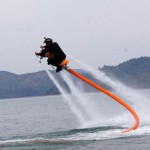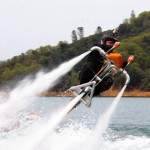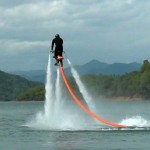The Jetovator is a water sports accessory that extends the ability of an existing personal watercraft (PWC). The Jetovator does not come with its own power source and customers must acquire their own high output PWC in order to power the Jetovator. The Jetovator redirects the water thrust from the jet unit of the PWC along a forty foot hose to the Jetovator body. This water thrust is then used to propel and elevate the Jetovator into the air. The rider can also redirect the water thrust of the two front nozzles in order to maneuver the Jetovator in all directions.
The PWC, which provides the power, follows behind the Jetovator using the hose as a tether. It is similar to other water sports accessories like wake boarding or water skiing except the accessory is actually towing the boat rather than the other way around. The 40 foot connecting hose is attached to the PWC via a supplied thrust adaptor that re-directs the jet thrust 180 degrees to the front of the PWC. This thrust adapter can be easily installed and removed, allowing the PWC to still be used as normal.
The standard Jetovator kit requires two people to operate it; a rider on the Jetovator controlling the height, and direction of the Jetovator, and a rider on the PWC controlling the throttle of the engine. Although this might sound complicated, generally the rider of the PWC just takes the throttle up to approximately 80% of full power and holds it there until the Jetovator rider is ready to come down (again, very similar to waterskiing or wakeboarding). A fly by wire throttle system allows the Jetovator to be ridden independently but this option will not be available until it has been thoroughly tested and approved for safe operation.
Having a trained operator on the PWC also makes the Jetovator an ideal rental vehicle for tourist destinations, as the PWC operator can apply the ideal amount of thrust based on the operators skill level. They can also cut the throttle at any time in the event that either the Jetovator or PWC comes too close to any other boat or object in the water. The PWC operator can also offer immediate assistance in the case of any problem.
Despite its impressive aerial capabilities, the Jetovator is actually incredibly easy to learn to operate. The idea of balancing atop a moving hose sounds impossible but the Jetovator provides such a stable platform that we can train just about anybody to operate it safely and proficiently in less than an hour.
The standard Jetovator can attain forward speeds of 25mph and riders can cruise in comfort for long distances should they choose to. The production Jetovator is limited to a height of 25 feet and can also dive under water for brief durations. Skilled riders can also perform freestyle tricks but it is recommend these only be attempted by well practiced operators in a safe environment clear of any other people or boats.
The Jetovator is a very safe, thoroughly tested water sports accessory but, like any powered water sport, it carries some risk. We highly recommend that both the PWC and Jetovator operators wear approved marine safety helmets in addition to their mandated life jackets. We also recommend that every Jetovator operator takes a minimum one hour training with an approved Jetovator trainer. All Jetovator distributors will be required to have at least one approved Jetovator trainer.
Click To View Images:
Article Written by: Jetovator.com







